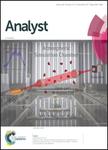版权所有:内蒙古大学图书馆 技术提供:维普资讯• 智图
内蒙古自治区呼和浩特市赛罕区大学西街235号 邮编: 010021

作者机构:Fudan Univ Xiamen Childrens Hosp Dept Clin Lab Childrens Hosp Xiamen Xiamen 361006 Peoples R China Anhui Med Univ Hefei 230032 Peoples R China Xiamen Radit Chinese Med Hosp Xiamen Key Lab Neonatal Dis Xiamen 361001 Peoples R China Fudan Univ Dept Clin Lab Childrens Hosp Shanghai 201102 Peoples R China Fujian Normal Univ Coll Life Sci Fuzhou 350117 Peoples R China
出 版 物:《ANALYST》 (分析化学家)
年 卷 期:2021年第146卷第13期
页 面:4391-4399页
核心收录:
学科分类:081704[工学-应用化学] 07[理学] 08[工学] 0817[工学-化学工程与技术] 070302[理学-分析化学] 0703[理学-化学]
基 金:Xiamen Medical and Health Guidance Project [3502Z20209212] Key Talent Cultivation Project of Xiamen Children's Hospital [CHP-2019BT006]
摘 要:Influenza A (H1N1) virus is a serious health threat and potential leading cause of death around the world during the processes of immunity and inflammation. Herein a sensitive pH-responsive point-of-care (POC) electrochemical immunoassay was designed for the quantitative monitoring of H1N1 influenza virus using glucose oxidase (GOx) and secondary antibody-functionalized Ti3C2-MXene nanosheets. The assay was carried out on the basis of the sandwich-type immunoreaction in the capture antibody-coated microplate. Two-dimensional (2D) Ti3C2-MXene nanosheets with a large surface area could efficiently enhance the loading amount of GOx molecules, thereby resulting in the signal amplification. Accompanying the formed immunocomplexes, labeled GOx molecules catalyzed glucose into gluconic acid and hydrogen peroxide. The generated gluconic acid caused a pH change of the detection solution, which was quantitatively determined on a handheld pH meter. Two labeling strategies with and without Ti3C2-MXene nanosheets were investigated to determine the target H1N1 influenza virus, and improved properties were acquired with the Ti3C2-MXene-labeled system. Under optimum conditions, the Ti3C2-MXene-based immunoassay gave good dynamic responses toward the target H1N1 influenza virus from 0.01 mu g mL(-1) to 100 mu g mL(-1) with a detection limit of 1.3 ng mL(-1). Good reproducibility, high specificity, and acceptable stability were also achieved in the analysis of the target H1N1 influenza virus. Significantly, measurements of the H1N1 influenza virus from clinical human samples were demonstrated to further confirm the method reliability and accuracy of the Ti3C2-MXene-based electrochemical immunoassay. Importantly, such a pH-meter-based immunoassay can be suitable for use in point-of-care applications and opens new opportunities for diagnostics.